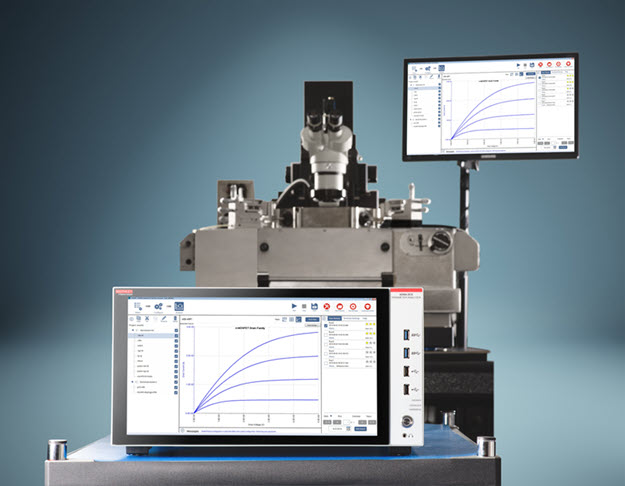

Controlling instruments remotely has become a part of nearly every engineer’s and researcher’s life, whether by working remotely or combining instruments into large test systems. The Keithley 4200A-SCS Parameter Analyzer supports a few different methods of remote control optimized for each scenario. This blog introduces remote control using Microsoft’s Remote Desktop Connection and the Keithley External Control Interface (KXCI).What is Remote Desktop Connection?
What is Remote Desktop Connection?
Remote Desktop Connection is a program included in Microsoft’s Windows 10 Operating System. It allows you to control a Windows 10 PC from a remote Windows PC. Because the 4200A-SCS runs Windows 10 natively, you can use this tool to control your 4200A-SCS too! Remote Desktop allows you to take full advantage of the Clarius software’s test and project library, intuitive test configuration and data analysis tools. There is no downtime to develop code and debug code, and previously configured projects and saved data can be quickly accessed. You can also use other Clarius+ Suite tools like the KULT Extension to develop user libraries. Remote Desktop facilitates a seamless transition between working in the lab and working from home.
How do I use Remote Desktop Connection with my 4200A-SCS?
Controlling your 4200A-SCS with Remote Desktop Connection is just as easy as controlling any Windows 10 PC. Both computers must be connected via LAN or the internet. For full instructions on connecting, see Microsoft’s support article here.
Once connected, you can use Clarius to control the 4200A-SCS’s instruments as shown in Figure 1. New runs of a project are stored in Clarius and can be exported from Clarius to either a shared network location or to the 4200A-SCS system, where they can be copied through the Remote Desktop connection. Remote Desktop is a great option if you want to get up and running fast without developing code.

Figure 1: Clarius viewed through Remote Desktop
What is KXCI?
Pronounced “kick-see”, KXCI is an interface included with the Clarius+ software suite that allows you control individual instruments inside the 4200A-SCS from a remote computer. Even though the parameter analyzer comes with easy-to-use interactive software called Clarius, sometimes you may want to control the instruments inside (modules) at a very granular level. This can be the case if the system will be part of a larger test setup that may include other instruments or for certain very specialized tests. Commands from the KXCI command set can configure the modules to make measurements and return the data to the controlling PC for analysis.
How do I use KXCI?
To get started, connect your 4200A-SCS to the remote PC through either GPIB or ethernet. On the 4200A-SCS, open KCON (Keithley Configuration Utility) and configure the KXCI settings to the interface you’ve chosen. Once configured, open the KXCI console. The 4200A-SCS is now ready to start receiving commands. The console, shown in Figure 2, contains a message pane for status messages, errors and echoed commands for debugging. There is also a pane for data to be graphed.

Figure 2: KXCI Console
KXCI commands are sent from the remote PC via any program of your choice. Several options for programming languages exist, and each have a few requirements to be able to communicate with the 4200A-SCS. Table 1 shows a few examples with any extra requirements to connect with the 4200A-SCS.
Table 1: Programming Languages to Send KXCI Commands
|
Language |
Communication Method |
Requirements |
Examples |
|
Python (Sockets) |
Ethernet |
Python socket library |
|
|
Python (pyVISA) |
Ethernet, GPIB |
||
|
C/C++ |
Ethernet |
KXCI Ethernet Driver (provided with Clarius software) |
|
|
C/C++ |
GPIB |
||
|
LabVIEW |
Ethernet, GPIB |
LabVIEW Driver |
|
|
MATLAB |
Ethernet, GPIB |
Instrument Control Toolbox |
Each module in the 4200A-SCS has its own set of commands to control them: Source Measure Units (SMUs), Capacitance-Voltage Units (CVUs), and Pulse Measure Units (PMUs).
- The SMU commands enable the user to configure the source and measure functions, timing settings, and initialize the test for measuring DC I-V.
- The CVU commands control the DC voltage, AC drive voltage, test frequency, timing settings, and other functionality to obtain C-V data.
- The PMU commands can only control sourcing with the PMU such as the pulse voltage and pulse timing.
- There are also KXCI commands to call and execute user modules written with the Keithley User Library Tool (KULT) or the KULT Extension on the 4200A-SCS. This extends the functionality of KXCI to measuring with the PMU and controlling external instruments like the CVIV multi-switch.
Every command for every instrument is described in the KXCI Remote Control Programming Reference Manual. The manual also contains information on configuring KXCI through KCON, program and command usage examples, and error codes. For hands on learning, a training module on KXCI can be found in the Learning Center of the Clarius software under Training Materials. This training contains tutorials to set up KXCI and the programming environment on the PC, verifying communications and example programs.
Try out the KXCI interface and start learning in the Learning Center by downloading the Clarius+ suite to your own PC for free.


